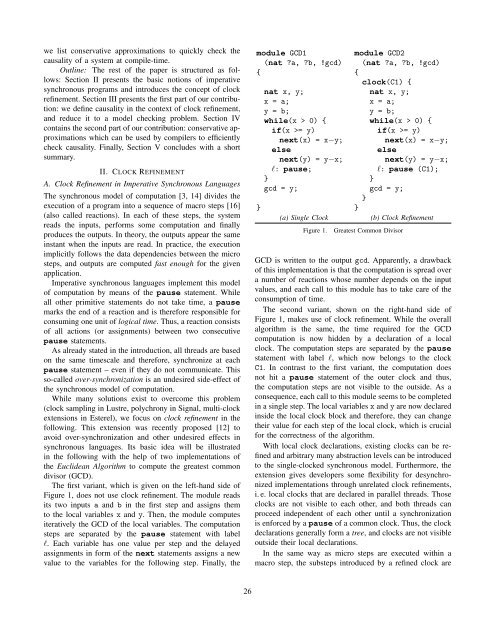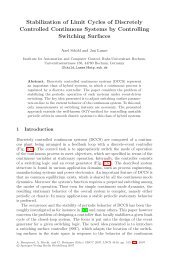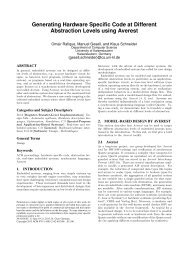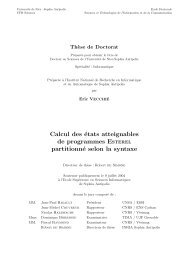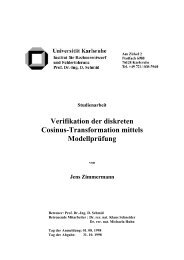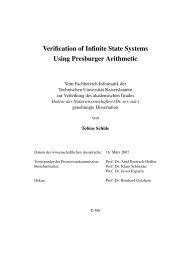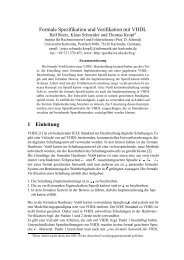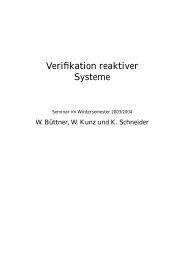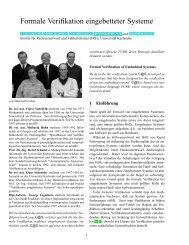Causality Analysis of Synchronous Programs with Refined Clocks
Causality Analysis of Synchronous Programs with Refined Clocks
Causality Analysis of Synchronous Programs with Refined Clocks
You also want an ePaper? Increase the reach of your titles
YUMPU automatically turns print PDFs into web optimized ePapers that Google loves.
we list conservative approximations to quickly check the<br />
causality <strong>of</strong> a system at compile-time.<br />
Outline: The rest <strong>of</strong> the paper is structured as follows:<br />
Section II presents the basic notions <strong>of</strong> imperative<br />
synchronous programs and introduces the concept <strong>of</strong> clock<br />
refinement. Section III presents the first part <strong>of</strong> our contribution:<br />
we define causality in the context <strong>of</strong> clock refinement,<br />
and reduce it to a model checking problem. Section IV<br />
contains the second part <strong>of</strong> our contribution: conservative approximations<br />
which can be used by compilers to efficiently<br />
check causality. Finally, Section V concludes <strong>with</strong> a short<br />
summary.<br />
II. CLOCK REFINEMENT<br />
A. Clock Refinement in Imperative <strong>Synchronous</strong> Languages<br />
The synchronous model <strong>of</strong> computation [3, 14] divides the<br />
execution <strong>of</strong> a program into a sequence <strong>of</strong> macro steps [16]<br />
(also called reactions). In each <strong>of</strong> these steps, the system<br />
reads the inputs, performs some computation and finally<br />
produces the outputs. In theory, the outputs appear the same<br />
instant when the inputs are read. In practice, the execution<br />
implicitly follows the data dependencies between the micro<br />
steps, and outputs are computed fast enough for the given<br />
application.<br />
Imperative synchronous languages implement this model<br />
<strong>of</strong> computation by means <strong>of</strong> the pause statement. While<br />
all other primitive statements do not take time, a pause<br />
marks the end <strong>of</strong> a reaction and is therefore responsible for<br />
consuming one unit <strong>of</strong> logical time. Thus, a reaction consists<br />
<strong>of</strong> all actions (or assignments) between two consecutive<br />
pause statements.<br />
As already stated in the introduction, all threads are based<br />
on the same timescale and therefore, synchronize at each<br />
pause statement – even if they do not communicate. This<br />
so-called over-synchronization is an undesired side-effect <strong>of</strong><br />
the synchronous model <strong>of</strong> computation.<br />
While many solutions exist to overcome this problem<br />
(clock sampling in Lustre, polychrony in Signal, multi-clock<br />
extensions in Esterel), we focus on clock refinement in the<br />
following. This extension was recently proposed [12] to<br />
avoid over-synchronization and other undesired effects in<br />
synchronous languages. Its basic idea will be illustrated<br />
in the following <strong>with</strong> the help <strong>of</strong> two implementations <strong>of</strong><br />
the Euclidean Algorithm to compute the greatest common<br />
divisor (GCD).<br />
The first variant, which is given on the left-hand side <strong>of</strong><br />
Figure 1, does not use clock refinement. The module reads<br />
its two inputs a and b in the first step and assigns them<br />
to the local variables x and y. Then, the module computes<br />
iteratively the GCD <strong>of</strong> the local variables. The computation<br />
steps are separated by the pause statement <strong>with</strong> label<br />
l. Each variable has one value per step and the delayed<br />
assignments in form <strong>of</strong> the next statements assigns a new<br />
value to the variables for the following step. Finally, the<br />
module GCD1<br />
(nat ?a, ?b, !gcd)<br />
{<br />
}<br />
nat x, y;<br />
x = a;<br />
y = b;<br />
while(x > 0) {<br />
if(x >= y)<br />
next(x) = x−y;<br />
else<br />
next(y) = y−x;<br />
l: pause;<br />
}<br />
gcd = y;<br />
(a) Single Clock<br />
Figure 1.<br />
module GCD2<br />
(nat ?a, ?b, !gcd)<br />
{<br />
clock(C1) {<br />
nat x, y;<br />
x = a;<br />
y = b;<br />
while(x > 0) {<br />
if(x >= y)<br />
next(x) = x−y;<br />
else<br />
next(y) = y−x;<br />
l: pause (C1);<br />
}<br />
gcd = y;<br />
}<br />
}<br />
(b) Clock Refinement<br />
Greatest Common Divisor<br />
GCD is written to the output gcd. Apparently, a drawback<br />
<strong>of</strong> this implementation is that the computation is spread over<br />
a number <strong>of</strong> reactions whose number depends on the input<br />
values, and each call to this module has to take care <strong>of</strong> the<br />
consumption <strong>of</strong> time.<br />
The second variant, shown on the right-hand side <strong>of</strong><br />
Figure 1, makes use <strong>of</strong> clock refinement. While the overall<br />
algorithm is the same, the time required for the GCD<br />
computation is now hidden by a declaration <strong>of</strong> a local<br />
clock. The computation steps are separated by the pause<br />
statement <strong>with</strong> label l, which now belongs to the clock<br />
C1. In contrast to the first variant, the computation does<br />
not hit a pause statement <strong>of</strong> the outer clock and thus,<br />
the computation steps are not visible to the outside. As a<br />
consequence, each call to this module seems to be completed<br />
in a single step. The local variables x and y are now declared<br />
inside the local clock block and therefore, they can change<br />
their value for each step <strong>of</strong> the local clock, which is crucial<br />
for the correctness <strong>of</strong> the algorithm.<br />
With local clock declarations, existing clocks can be refined<br />
and arbitrary many abstraction levels can be introduced<br />
to the single-clocked synchronous model. Furthermore, the<br />
extension gives developers some flexibility for desynchronized<br />
implementations through unrelated clock refinements,<br />
i. e. local clocks that are declared in parallel threads. Those<br />
clocks are not visible to each other, and both threads can<br />
proceed independent <strong>of</strong> each other until a synchronization<br />
is enforced by a pause <strong>of</strong> a common clock. Thus, the clock<br />
declarations generally form a tree, and clocks are not visible<br />
outside their local declarations.<br />
In the same way as micro steps are executed <strong>with</strong>in a<br />
macro step, the substeps introduced by a refined clock are<br />
26


